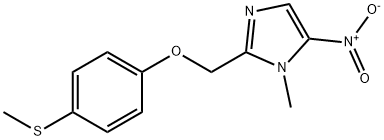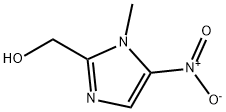Fexinidazole
- CAS NO.:59729-37-2
- Empirical Formula: C12H13N3O3S
- Molecular Weight: 279.31
- MDL number: MFCD00866607
- SAFETY DATA SHEET (SDS)
- Update Date: 2024-11-19 15:53:33

What is Fexinidazole?
Absorption
Fexinidazole is well absorbed, although the rate and extent of absorption are less than dose-proportional; after a 14-day administration schedule, the mean Cmax and AUClast increased by 1.17 and 1.34, or by 1.5 and 1.61, when the dose was either doubled or tripled. Following absorption, fexinidazole is rapidly converted to its M1 metabolite, which undergoes a slower transformation to M2 over time. This is reflected in the Tmax of fexinidazole, M1, and M2 as 4 (0-9), 4 (0-6), and 6 (0-24) hours, respectively.
In healthy adults given an 1800 mg loading dose followed by 1200 mg daily over 14 days, the mean Cmax for fexinidazole was 1.6 ± 0.4 μg/mL on day 1, 0.8 ± 0.3 μg/mL on day 2, and 0.5 ± 0.2 μg/mL on day 3. The relevant values for M1 were 8.1 ± 2.2, 8.0 ± 2.3, and 5.9 ± 2.1, while for M2 they were 7.5 ± 3.3, 19.6 ± 5.4, and 12.5 ± 3.5 μg/mL. Similarly, the AUC for fexinidazole was 14.3 ± 2.6, 11.6 ± 2.2, and 7.0 ± 2.5, for M1 was 102.3 ± 28.5, 127.9 ± 49.2, and 84.2 ± 36.3, and for M2 was 110.1 ± 41.1, 391.5 ± 126.7, and 252.4 ± 73.6 μg*h/mL. Concomitant food intake increases the Cmax and AUC of fexinidazole, M1, and M2 by 2-5 fold without significantly changing the metabolite ratios.
There are no clear effects of age, renal, or hepatic impairment on absorption or plasma parameters of fexinidazole or its metabolites; further studies may be required to confirm/refute these observations.
Toxicity
Healthy male adult volunteers were administered single or multiple daily doses of up to 3600 mg for 14 days and experienced elevated liver transaminases, vomiting, and panic attacks. Pediatric HAT patients given higher than recommended doses experienced vomiting, increased potassium, and decreased calcium levels. There is no specific antidote to fexinidazole; symptomatic and supportive measures are recommended in case of overdose.
Rats and beagles given up to 800 mg/kg/day of fexinidazole showed mild appetite and body weight alterations but no clear hepatotoxicity. Fexinidazole did not induce any effects on embryo-fetal and postnatal development when administered to pregnant rats. Although fexinidazole is mutagenic in a standard Ames test, it is not anticipated to be genotoxic in humans.
The Uses of Fexinidazole
Fexinidazole is a medication used in the treatment of African trypanosomiasis caused by trypanosoma brucei gambiense. An antitrypanosomal agent. It also functions as a medication used against the main species that cause visceral and cutaneous new World leishmaniasis.
Background
Human African trypanosomiasis (HAT, also colloquially referred to as sleeping sickness), caused by T. brucei gambiense and T. brucei rhodesiense, remains a moderate risk (>1/10,000 inhabitants per year in endemic areas) despite focussed control efforts. Transmitted by the bite of an infected tsetse fly, HAT is biphasic with a first (hemolymphatic) stage that progresses to a second (meningoencephalitic) stage in which patients experience progressively worsening neurological symptoms and eventually die if left untreated. Historical treatment options for meningoencephalitic HAT include melarsoprol, eflornithine, and nifurtimox/eflornithine combination therapy (NECT), though melarsoprol is highly toxic and each treatment requires lengthy infusions that are difficult to administer in resource-limited settings. Fexinidazole, which was originally developed in the 1970s/80s by Hoechst AG and subsequently rediscovered through the Drugs for Neglected Diseases Initiative (DNDi) in 2005, is the first all-oral treatment for first and second stage HAT caused by T. brucei gambiense.
Fexinidazole received a positive opinion from the European Medicines Agency (EMA) in November 2018 and was approved by the FDA on July 16, 2021. It is currently marketed by Sanofi-Aventis.
Indications
Fexinidazole is a nitroimidazole indicated for the treatment of both first-stage (hemolymphatic) and second-stage (meningoencephalitic) Trypanosoma brucei gambiense human African trypanosomiasis (HAT) in patients 6 years of age and older weighing at least 20 kg.
Due to the decreased efficacy observed in patients with severe second stage HAT (cerebrospinal fluid white blood cell count (CSF-WBC) >100 cells/μL), fexinidazole should only be used in these patients if there are no other available treatment options.
Pharmacokinetics
Fexinidazole is a 2-substituted 5-nitroimidazole that is likely activated by parasitic nitroreductases to highly reactive species, leading to DNA and protein damage and eventual parasite death. The dosing schedule is designed to ensure a high enough concentration of fexinidazole and its reactive metabolites for at least 48 hours, which from in vitro studies was shown to be the minimum exposure time that was effectively trypanocidal. Although fexinidazole is effective in late-stage T. brucei gambiense HAT, it is less effective than NECT therapy in patients with severe (cerebrospinal fluid white blood cell count (CSF-WBC) >100 cells/μL at baseline) disease. It should only be used in these patients if there are no other available treatment options. Fexinidazole has been shown to prolong the QT interval in a dose-dependent manner and was also associated with a higher incidence of insomnia, headache, tremors, psychiatric disorders, and suicidal ideation in clinical trials; patients with pre-existing conditions or concomitant medications that could aggravate any of these effects should be treated with caution. In addition, fexinidazole has been associated with neutropenia and elevations in liver transaminases, which should be monitored. Nitroimidazoles like fexinidazole have been associated with a disulfiram-like reaction when used concomitantly with alcohol and psychotic reactions when taken with disulfiram itself; patients should avoid alcohol and disulfiram when taking fexinidazole.
Metabolism
Fexinidazole is metabolized by a variety of enzymes including the CYP450 enzymes CYP1A2, 2B6, 2C19, 2D6, 3A4, and 3A5 as well as flavin mono-oxygenase-3 (FMO-3). Fexinidazole is first transformed to the sulfoxide M1 and then the sulfone M2, which does not appear to undergo further metabolism.
Properties of Fexinidazole
| Boiling point: | 501 °C |
| Density | 1.33±0.1 g/cm3(Predicted) |
| storage temp. | Sealed in dry,Room Temperature |
| solubility | DMF: 20 mg/mL; DMF:PBS (pH 7.2) (1:8): 0.11 mg/mL; DMSO: 10 mg/mL; Ethanol: 0.2 mg/mL |
| form | A crystalline solid |
| pka | 1.82±0.25(Predicted) |
| color | Light yellow to yellow |
Safety information for Fexinidazole
Computed Descriptors for Fexinidazole
New Products
Tert-butyl bis(2-chloroethyl)carbamate (S)-3-Aminobutanenitrile hydrochloride N-Boc-D-alaninol N-BOC-D/L-ALANINOL N-octanoyl benzotriazole 3,4-Dibenzyloxybenzaldehyde 4-Hydrazinobenzoic acid 1,1’-CARBONYLDIIMIDAZOLE R-2-BENZYLOXY PROPIONIC ACID 3-NITRO-2-METHYL ANILINE 4-IODO BENZOIC ACID 4-HYDROXY BENZYL ALCOHOL 4-(3-chloropropyl)morpholine phenylhydrazine hydrochloride (2-Hydroxyphenyl)acetonitrile 4-Bromopyrazole 5-BROMO-2CYANO PYRIDINE 5,6-Dimethoxyindanone 5-broMo-2-chloro-N-cyclopentylpyriMidin-4-aMine 4-methoxy-3,5-dinitropyridine 2-(Cyanocyclohexyl)acetic acid 2-aminopropyl benzoate hydrochloride 1-(4-(aminomethyl)benzyl)urea hydrochloride tert-butyl 4- (ureidomethyl)benzylcarbamateRelated products of tetrahydrofuran





You may like
-
 Fexinidazole 96% CAS 59729-37-2View Details
Fexinidazole 96% CAS 59729-37-2View Details
59729-37-2 -
 (9H-fluoren-9-yl)methyl (2,5-dioxopyrrolidin-1-yl) carbonate 82911-69-1 98.0%View Details
(9H-fluoren-9-yl)methyl (2,5-dioxopyrrolidin-1-yl) carbonate 82911-69-1 98.0%View Details
82911-69-1 -
 13057-17-5 95.0%View Details
13057-17-5 95.0%View Details
13057-17-5 -
 4-bromoaniline 106-40-1 99.0%View Details
4-bromoaniline 106-40-1 99.0%View Details
106-40-1 -
 1421517-99-8 99.0%View Details
1421517-99-8 99.0%View Details
1421517-99-8 -
 5-bromo-2-chlorobenzoic acid 99.0%View Details
5-bromo-2-chlorobenzoic acid 99.0%View Details
21739-92-4 -
 2-methyl-5-nitrophenol 98.0%View Details
2-methyl-5-nitrophenol 98.0%View Details
5428-54-6 -
 15761-38-3 97.0%View Details
15761-38-3 97.0%View Details
15761-38-3